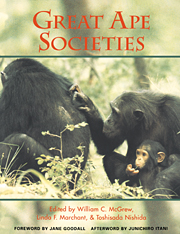Book contents
- Frontmatter
- Contents
- List of contributors
- Preface
- Foreword: conserving great apes
- Part I Apes overviewed
- Part II Social ecology
- Part III Social relations
- Part IV Minds
- 12 Conflict as negotiation
- 13 Language perceived: Paniscus branches out
- 14 Reciprocation in apes: from complex cognition to self-structuring
- 15 Chimpanzee intelligence in nature and in captivity: isomorphism of symbol use and tool use
- Part V Apes compared
- Part VI Modeling ourselves
- Afterword: a new milestone in great ape research
- Appendix: great ape study sites
- Index
14 - Reciprocation in apes: from complex cognition to self-structuring
Published online by Cambridge University Press: 04 August 2010
- Frontmatter
- Contents
- List of contributors
- Preface
- Foreword: conserving great apes
- Part I Apes overviewed
- Part II Social ecology
- Part III Social relations
- Part IV Minds
- 12 Conflict as negotiation
- 13 Language perceived: Paniscus branches out
- 14 Reciprocation in apes: from complex cognition to self-structuring
- 15 Chimpanzee intelligence in nature and in captivity: isomorphism of symbol use and tool use
- Part V Apes compared
- Part VI Modeling ourselves
- Afterword: a new milestone in great ape research
- Appendix: great ape study sites
- Index
Summary
INTRODUCTION
Although the great apes, as our nearest relatives, are a valuable subject for cognitive research, it remains difficult to gain insights into their mental abilities. Some of the problems are reflected in a debate between Kummer et al. (1990) and de Waal (1991) over the question of at what stage of research (anecdotal, correlational or experimental) anthropomorphic labels for behavior are allowable, if ever. Whereas de Waal uses these terms deliberately throughout his writings, Kummer and his co-authors argue that such terms should not be used unless more parsimonious alternative hypotheses are excluded by experimental evidence.
Although this discussion lays bare some of the difficulties in cognitive primatological research, it does not attack its central problem: how to go beyond anthropomorphic labeling by generating meaningful alternative hypotheses. The central thesis of the present paper is that adopting a view based on self-organization provides us with a tool to generate such alternatives.
Thinking in terms of self-structuring asks for a different way of thinking about complexity. By convention it is believed that a complex system can be understood by taking it apart and studying the pieces. This analytic procedure, also known as the ‘top-down’ or reductionist approach, boils down to a static description of the system. Supporters of the self-structuring view, however, advocate an opposite route: by studying interactions on a lower level, the emergence of a macrostructure on a higher level is perceived and therefore better understood (Hogeweg, 1988).
- Type
- Chapter
- Information
- Great Ape Societies , pp. 185 - 195Publisher: Cambridge University PressPrint publication year: 1996
- 15
- Cited by



